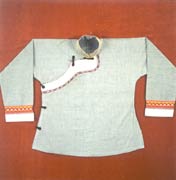The nationality engaged both in industry and agriculture  The Mulao ethnic minority has a population of about 160,000, of which over 150,000, more than 90 per cent, live in the Guangxi Zhuang Autonomous Region. Others are scattered in neighboring counties. On June 15 of 1993, another 30,000 "Mulao people" living in the Guizhou Province are recognized as the Mulao ethnic minority. The Mulao ethnic minority has a population of about 160,000, of which over 150,000, more than 90 per cent, live in the Guangxi Zhuang Autonomous Region. Others are scattered in neighboring counties. On June 15 of 1993, another 30,000 "Mulao people" living in the Guizhou Province are recognized as the Mulao ethnic minority.
The majority of Mulao people in the Guangxi Zhuang Autonomous Region live in concentrated communities in Mulao Autonomous County of Luocheng, Xincheng county, Liujiang county, Liuzhou, Hechi, Du'an, and Zhujiang. The ethnic group lives together with Zhuang, Yao, Miao, Han, and Dong people, featuring dispersed broadly and inhabiting concentratedly.
Mulao people calling themselves "Mu Lao," is firstly recorded in the historical books of the Northern and Southern Dynasties. Till the Song, Yuan, Ming, and Qing dynasties, other names like "Mu Lou Di," have also been recorded. In 1956, the name "Mulao" is finally decided with the approval of the State Council.
The Mulao ethnic group has its own language, a member of the Zhuang-Dong language group of the Chinese-Tibetan language family, which is quite close to Zhuang, Buyi, Dai, Maonan, Dong, Shui, and Li languages. Many Mulao people can also speak Chinese, Zhuang Language or Miao and Dong languages.
Known as "small Guilin," their homeland is one of rolling hills interspersed with lush green valleys. There are abundant tourism resources.
Mulao people mainly rely on agriculture. The cereal crops include rice and maize, and the industrial crops are sugarcane, rape, cassava, etc. Also their inhabited region is abundant in tea, mushroom, agaric as well as mineral deposit of coal, iron, tin, sulphur, etc. Its industries of iron forging, pottery making and mining are comparatively developed.
Mulao people favor the sour food. Their clothes are simple and mostly in deep blue, taking the cloth weaved and dyed by themselves as raw materials. Woman generally wear blouse and long trousers, wearing their hair in buns wrapped with deep blue cloth. The houses are mostly made up of mud or bricks, with coal-burning ground stoves in the rooms.
<<
The Coal Village >>
|